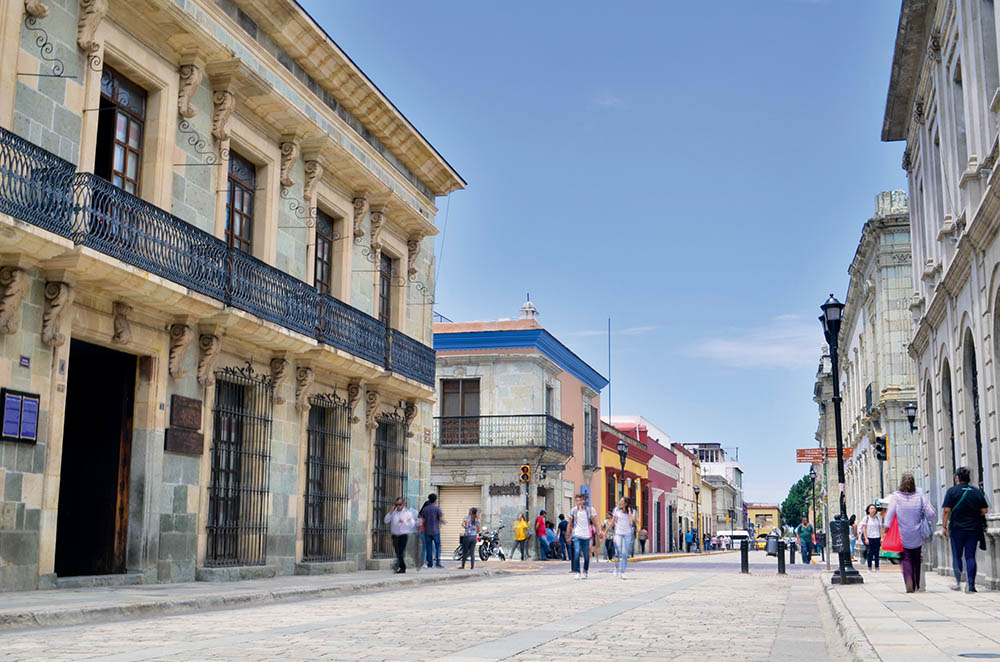The city of Oaxaca and its surrounding state are together one of the most culturally rich areas of Mexico. A stronghold for indigenous peoples including the Mixtec and Zapotec, whose traditions predate the Spanish conquest by centuries, the region has several important archeological sites. There’s also amazing museums and a unique cuisine. So, if you’ve ever wondered what Oaxaca is famous for, sit back and let us guide you through its many wonders!
The Zócalo and Cathedral

The heart of the city for centuries, the Zócalo is Oaxaca’s main square. A respite from the traffic of surrounding streets, its centuries old cobblestones instead throb with the strumming guitars of traditional Oaxacan bands, hawkers looking to sell their trinkets and people of all ages soaking up the atmosphere.
The best way to do this is to sit beneath the umbrellas at one of the cafés located within the arcaded buildings that surround the square. Slowly building in tempo as the day progresses, its south side is dominated by a grand governor’s palace, its northern side is the location of Oaxaca Cathedral.
Officially known as the Catedral de Nuestra Señora de la Asunción (the Cathedral of Our Lady of the Ascension), this grand edifice has stood proud through revolution, celebration and earthquakes. Started in 1535, it is made of a green stone quarried nearby which gives Oaxaca its unusual tone, and demonstrates the riches that Spain found in the region in its stunning interior decoration.
Oaxaca Cultural Museum
Widely recognized as one of the top museums in the country, Oaxaca Cultural Museum (look out for references to the Museo de las Culturas de Oaxaca) is definitely one of the attractions that Oaxaca is famous for.
A combination of ethnographic and history museum, its vast collection guides visitors through the customs of the region from pre-Hispanic times onwards, demonstrating just how many of these ancient ways of life have continued to contemporary times. Several galleries are also based around themes such as medicine and music to show how culture has endured over the years.
Specific treasures include a Mixtec royal burial haul rich in gold and precious stones rediscovered on Monte Albán in the 1930s. It’s best explored with the audio guide of which there is an English version. The impressive monastery buildings that contain it are similarly impressive.
Templo de Santo Domingo and the Ethnobotanical Garden
Right next door to the Oaxaca Cultural Museum is the Templo de Santo Domingo. Believe it or not, this church manages to even outdo Oaxaca Cathedral in the craftsmanship it displays, with a rich array of religious figures forming just part of the decoration. It also includes some of the most elaborate ceiling detail you’re ever likely to see, so look up!
Take just a few steps beyond its thick earthquake-proof walls and you’ll discover another wonder – the Ethnobotanical Garden. Although work on the garden only began a generation ago, it quickly became a place to escape the heat beneath the shade of a tree while enjoying the full spectrum of plants native to the region. Dotted in between you’ll find works of art by some of the region’s greatest living artists.
The Ruins of Mitla
Easily reachable from the hotels of Oaxaca, the Ruins of Mitla are probably the most important archeological site belonging to the Zapotec culture, and is therefore understandably what Oaxaca is famous for.
Almost hidden in high valleys surrounded by the Sierra Madre del Sur Mountains, its name means ‘place of the dead’ or ‘place of rest’. A UNESCO World Heritage Site since 2010, the earliest structures at Mitla have been dated to as early as 450 AD and it was still a thriving city when the Spanish arrived and ultimately destroyed it.
Although described as ruins, good amounts of many structures remain, helping to reveal what the city must have been like in its heyday. They include the grand palace, whose main hall stretches for over 36 meters, and the Zapotec’s primary temple now part of the so-called Church Group of structures built by the Spanish. The Church Group is also well known for the presence of its stone friezes, made from thousands of pieces of small deliberately cut stone stacked on top of one another to form intricate geometric patterns.
Food and Drink
The cultural prowess of Oaxaca extends as far as its kitchens and its mezcal distilleries, with the city considered one of the best destinations in Mexico to sample authentic cuisine.
Tour one of the city’s markets and it’s likely you’ll come across chapulines, a delicacy of fried grasshoppers, as well as chicatanas, flying ants, for adding a little crunch to your meal. These are some of the more unusual foods that can be tried in the city. But there’s also plenty to keep the squeamish satisfied too, with Michelin-starred restaurants popping up across the city and street food that is equally appealing. Tamales, tacos and tlayudas are some of the most popular dishes around.
However, what really brings them to life are the moles (sauces) for which the city is famed. Depending on the ingredients they include red, green, yellow, and black sauces, with the latter a thick rich sauce made with chocolate, cinnamon and cloves.
When it comes to drinks there’s one not to miss, and that’s mezcal. Made from the distillation of the heart (or piña) of the agave plant of which there are many varieties in the state of Oaxaca. Mezcal can be anywhere between 40 and 55% alcohol by volume, so if you join a tasting tour, be sure to take it slow!
What Oaxaca is Famous For – Final Thoughts
The list of what Oaxaca is famous for is a long one! First there’s the cultures of indigenous peoples that have survived against the odds for centuries. Then there are the monumental structures built during the Spanish era, and then the region’s unique culture including its art and cuisine. Among these there are the kind and welcoming locals which together create a fantastic introduction to everything that makes this part of Mexico special.

